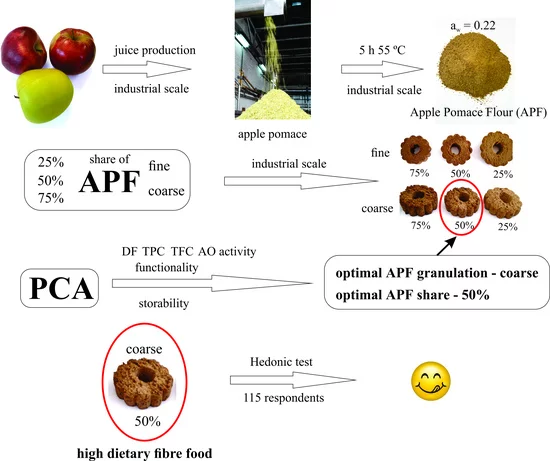Health-conscious humans are paying more and more attention to ingredients. Food manufacturers are constantly reducing the content of biscuits and pizzas, phasing out trans-fatty acids and artificial flavors, and are also keen to find alternatives to high-calorie foods. Beef and fish are not enough to make with the plants. In the next step, even the flour is made of fruit. To be precise, it is apple pomace.

▲ Image from: T&DG
Pomace is a residual fruit after juicing. Its usual destination is not a dump or a livestock feed trough, but its nutritional value is not low: 54% pulp, 34% peel, 7% seeds, 4 % of the seed core and 2% of the stem, so sometimes it will also be used to make some simple foods, such as jam, but you may not have thought that the pomace can also be used as flour.
The University of Belgrade researchers at the Food” magazine on November 8th Published the results of their use of apple pomace to make biscuits.

▲Image from: MDPI
Fresh apple pomace contains a lot of water, so the first step in making flour is dehydration, draining the pomace residue on a sloping surface, crushing it into pieces, and then After drying with hot air or sunlight, after two or three days of treatment, the dehydrated pomace can be placed in a sealed bag and processed into a powder.
However, in actual use, the researchers took the pomace powder and wheat flourA combination of proportions to achieve a balance of taste and texture. It has been tested to maintain the taste of the biscuits within the consumer’s acceptance when the proportion of the pomace powder is at most 50%.
It sounds quite reliable, but there are still many problems to overcome in industrial production. We know that it is necessary to add water when mixing dough, and the pomace powder has a stronger water absorption due to the porous structure of the cell wall, so that the dough of the same consistency is produced, and the water of the pomace powder is much more than the wheat flour.
From a nutritional point of view, bread made from pomace powder instead of wheat flour may have certain advantages. For example, the plant fiber content is 4 times that of refined white flour. These fibers help digestion, intestinal health, and cholesterol. Level, keep blood sugar stable, etc., and can maintain a long-term satiety and reduce the desire for excessive diet, exaggerated, pomace powder can also help to lose weight. In addition to fruits and vegetables, pomace powder may become a new source of dietary fiber, which may be a good alternative for people who do not like fruits and vegetables.
In addition, pomace powder is usually gluten-free and is in line with the current gluten-free diet.
“Because of the rising incidence of various metabolic disorders, obesity and gluten intolerance, people are interested in developing enhanced products with high dietary fiber and antioxidants,” the researchers wrote.
For the Apple industry, this may also be a new business opportunity, juice producers can turn the often discarded pomace into a waste to avoid waste. In addition, the researchers also found that adding pomace powder can also extend the shelf life of food.
The University of Auckland has had similar projects. They chose not only apples, but also oranges, kiwis, Portugal and other fruits commonly used for juicing. The project has also been supported by the New Zealand government.
Overall, because of the advantages of Apple itself, and the fact that the processing does not involve technology such as genetic modification, “apple flour” seems to be the most popular product among the innovative ingredients.
The title map is from: Unsplash